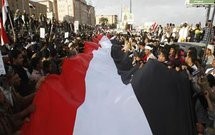 An ongoing rebel offensive in Yemen is, in many ways, a continuation of what the Arab state has seen since the establishment of a republican polity in 1962. The hyper-fragmentation of the country's political establishment since the ill-fated 2011 Arab Spring shows that the two decades that followed Yemeni unification in 1990 were an anomaly. Yemen has reverted to its natural state, in which different geographic, sectarian and ideological forces are locked in a "balance of weakness" preventing the country from existing as a coherent polity.
An ongoing rebel offensive in Yemen is, in many ways, a continuation of what the Arab state has seen since the establishment of a republican polity in 1962. The hyper-fragmentation of the country's political establishment since the ill-fated 2011 Arab Spring shows that the two decades that followed Yemeni unification in 1990 were an anomaly. Yemen has reverted to its natural state, in which different geographic, sectarian and ideological forces are locked in a "balance of weakness" preventing the country from existing as a coherent polity.
On Saturday, militiamen associated with the al-Houthi rebel movement — affiliated with the Zaidi sect of Shi'ism found in northern Yemen — allegedly kidnapped Ahmed Awad Bin Mubarak, the chief of staff to Yemeni President Abd Rabboh Mansour Hadi. Mubarak, a technocrat who was reportedly rejected by the al-Houthis in 2014 as a candidate for prime minister because of his close links to Hadi, was due to present a draft of Yemen's new constitution to the president. The al-Houthis oppose the new charter, and it appears that the abduction took place to prevent it from moving forward.
The envisioned charter calls for the reorganization of Yemen into six administrative regions. Led by the charismatic Abdul-Malik al-Houthi and his tribesmen, the al-Houthis are calling instead for two such regions — northern and southern — which would enable the movement to consolidate its recent territorial gains in an area spanning from its northern strongholds to the capital, Sanaa, and even farther south.
The core of the al-Houthi movement consists of a Zaidi tribal alliance led by the al-Houthi clan. Despite months of expansion from the movement's base in the northern Saada province, the limits of the al-Houthi's influence has been made obvious by the serious resistance from the Yemeni military it is facing in Marib, Ibb and Bayda provinces. The al-Houthis themselves can go only so far in pushing southward. The al-Houthis are also well aware that Yemen's southern separatists — with whom they would ultimately like to share power — have been weakened by internal differences and the presence of al Qaeda in the Arabian Peninsula in the south.
Thus, the movement is not seeking to replace the Yemeni military-dominated political order established by former President Ali Abdullah Saleh — a dynamic that is struggling to persevere under the leadership of Saleh's successor, Hadi. Instead, the al-Houthis are aiming to become the kingmakers in a new power-sharing system divided into the northern and southern administrative regions, in which the movement and the southern separatists would have the majority of power, with establishment factions as junior stakeholders. The al-Houthis are willing to allow the old guard led by Hadi to maintain some semblance of a central government in Sanaa — at least until the movement can further solidify its position and the southerners are able to gain ground in their own region.
Certainly the al-Houthis have emerged as the largest political force in the country, but they remain locked in a balance of weakness involving the old order, anti-Houthi tribes, al Qaeda and the southern separatists. It is unlikely that the al-Houthis will be able to break out from this constrained order anytime soon. But considering the broader geo-sectarian struggle between Saudi Arabia and Iran (in which Yemen has become a key battleground) and the sheer number of camps and competing factions within the two main Yemeni separatist movements, Yemen over the long haul will not be able to exist as a nation-state in the classical sense of the term.
The Yemeni condition represents the broad general trend within the Arab world that remains in the throes of autocratic meltdown, as seen in Libya and Syria. The states that remain standing — namely Saudi Arabia and Egypt — face similar challenges of how to maintain their dominions in such an anarchic environment.
Courtesy : Stratfor (www.stratfor.com)